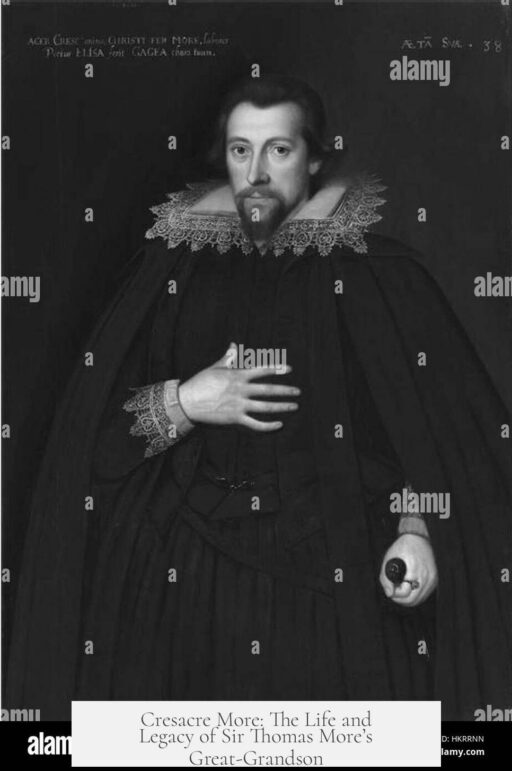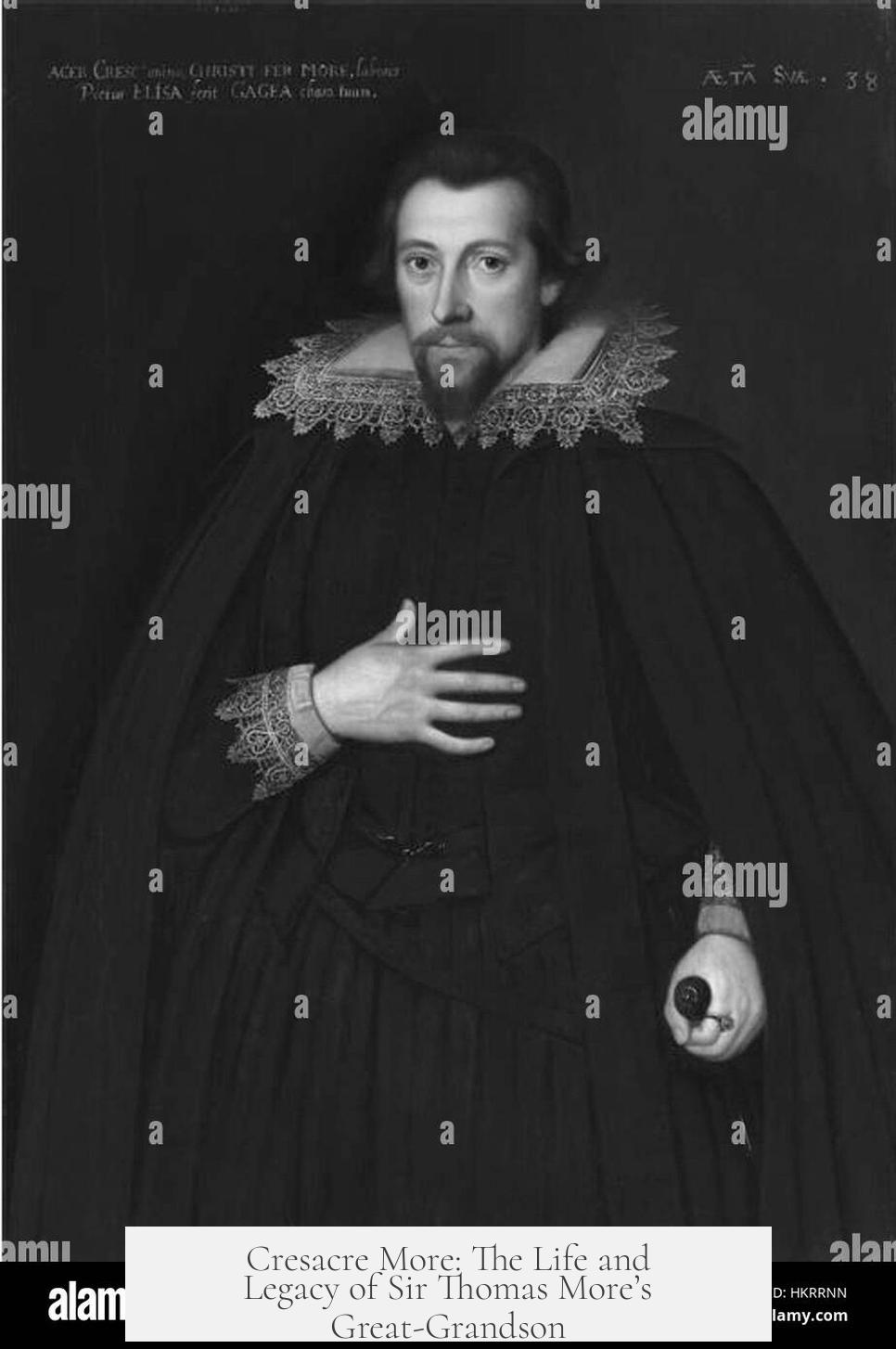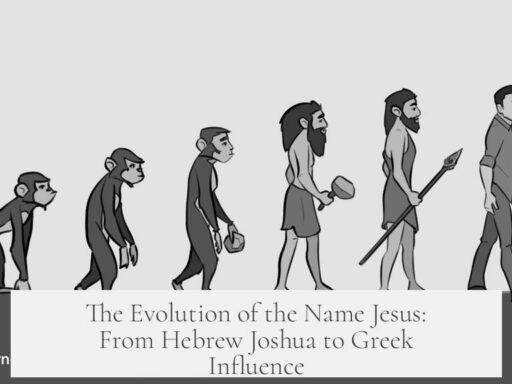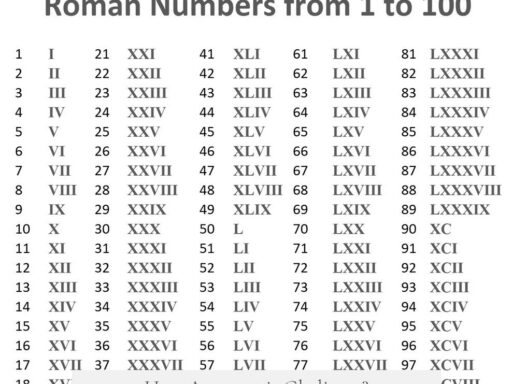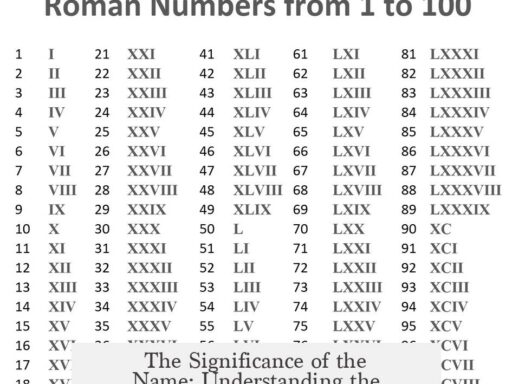Cresacre More, the great-grandson of Sir Thomas More, lived a life marked by religious devotion, family duty, and political turbulence. Born in Yorkshire as the youngest of thirteen children, he inherited his family’s estates across Yorkshire and Hertfordshire after his father’s death in 1606. Though initially prepared for a life in the Church, he withdrew from full religious orders to manage familial responsibilities and uphold the Catholic faith during a time of English religious conflict.
Cresacre More’s early life reflected his noble and Catholic lineage. His father, also named Thomas More, was a gentleman and landowner, while his mother, Maria Scrope, descended from local nobility. To prepare for a potential ecclesiastical career, Cresacre attended a Jesuit school in northern France at age 12, followed by studies at the English College in Rheims. He was tonsured in 1590 and intended to become a monk, but family circumstances, notably the death of his eldest brother, required his return to England. He did not take full religious orders, balancing devotion with secular obligations.
Upon his father’s death in 1606, Cresacre, despite being the youngest sibling, became the heir to valuable lands in Yorkshire and Hertfordshire. These estates positioned him as a significant landowner with ties both in the north of England and near London. Cresacre married and had three children. His son was prepared to inherit these estates, while both daughters chose religious life as Benedictine nuns, reflecting the family’s continued Catholic identity.
Cresacre remained steadfast in his Catholicism during a period of Protestant dominance and penal laws against recusants. He regularly paid fines for refusing to attend Anglican services, demonstrating his commitment to his faith despite potential social and legal penalties. During this time, he lived for many years in Essex and later in Mimms, Hertfordshire, from 1617 until shortly before his death.
Between approximately 1616 and 1620, Cresacre authored a biography of his great-grandfather, Sir Thomas More. This work was published after 1626 in Douai, located in the Spanish Netherlands, a center of Catholic exile publishing. The authorship attribution within the book is ambiguous; while the dedication indicates Cresacre’s older brother Thomas, a secular Catholic priest, as the author, other sections clearly point to Cresacre himself. Modern scholarship attributes the biography to Cresacre, though this caused him no documented difficulties at the time.
In terms of property management, Cresacre transferred his Hertfordshire estates to his son in 1629. This move happened over twenty years before his death. Later in life, he lived on a leasehold property near Hereford, in western England, where he died in 1649. The timing coincides with the English Civil War, a conflict marked by royalist and parliamentarian divisions. Cresacre and his family likely supported the royalist cause, as indicated by their apparent relocation away from Hertfordshire and Essex—both parliamentarian strongholds during the war. This support for the monarchy aligns with the family’s enduring Catholic identity, which often correlated with royalist sympathies in that era.
| Aspect | Details |
|---|---|
| Birthplace & Family | Yorkshire; youngest of 13 children to Thomas More and Maria Scrope |
| Education | Jesuit school and English College in Rheims; tonsured but no full ordination |
| Inheritance | Heir to family estates in Yorkshire and Hertfordshire after 1606 |
| Family Life | Married with three children; daughters became Benedictine nuns |
| Religious Practice | Committed Catholic; paid recusancy fines |
| Authorship | Wrote biography of Sir Thomas More published post-1626 at Douai |
| Political Alignment | Likely royalist supporter during English Civil War |
| Death | Died near Hereford in 1649 |
In summary, Cresacre More lived as a landowner balancing faith and family duty during a fractious period in English history. He never completed religious orders but maintained a strong Catholic identity. His literary work immortalized his great-grandfather’s legacy. He managed the family estates carefully, passing them on to his son before dying during the turmoil of the civil war, likely as a royalist sympathizer.
- Cresacre inherited significant estates despite being the youngest sibling.
- He initially pursued a religious path but did not take full orders.
- Authored a biography of Sir Thomas More published abroad in the 1620s.
- Remained a practicing Catholic and paid fines for recusancy.
- Likely supported the royalist cause during the English Civil War.
- Died in 1649 near Hereford, having transferred his estates to his son decades earlier.
What happened to Sir Thomas More’s great-grandson, Cresacre More?
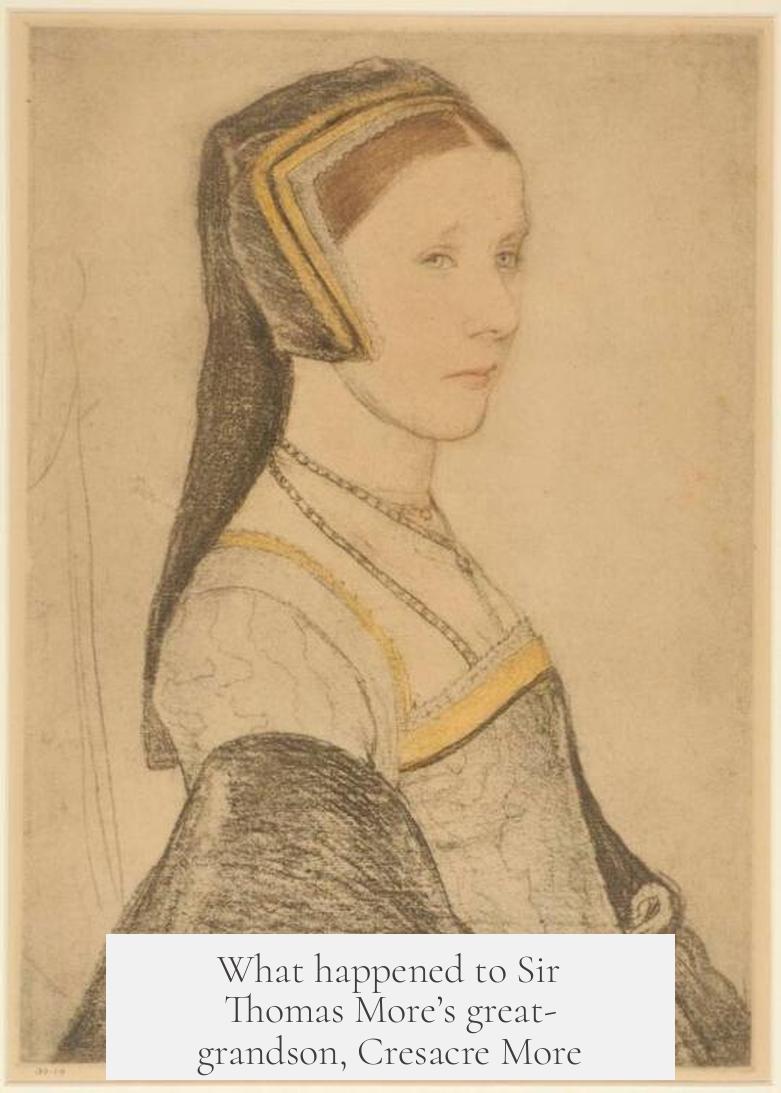
Cresacre More, Sir Thomas More’s great-grandson, lived a life marked by faith, family duty, and political turmoil, ultimately becoming a Catholic landowner, biographer, and royalist sympathizer before passing away in 1649. But how did his story unfold amid the shifting tides of 16th- and 17th-century England? Let’s journey through Cresacre’s life to discover the man behind the name.
Born into a Large, Noble Catholic Family
Born in 1572 in Yorkshire, Cresacre was the youngest of 13 children. Yes, thirteen! His father was another Thomas More, a gentleman who managed family estates scattered across Yorkshire and Hertfordshire. His mother, Maria Scrope, had noble blood. So, Cresacre entered a world of land, legacy, and religious conviction.
This wasn’t just any noble household—faith was the centerpiece. The More family clung to Catholicism during England’s Protestant upheaval. Imagine growing up knowing your faith might cost you everything—that was their reality.
Groomed for God but Pulled Back to Family
At age 12, Cresacre was shipped off to a Jesuit school in northern France, a move to safeguard his Catholic education away from Protestant England’s watchful eyes. Two years later, he advanced to the English College at Rheims, a hub for English Catholics in exile. In 1590, he took minor orders and was tonsured, positioning himself on the path to becoming a monk.
Yet in a twist, when his eldest brother died, Cresacre was recalled to England to inherit the family estates. So he remained tonsured but never took full holy orders. Family duties won over clerical calling.
Heir to Family Estates and Responsibilities
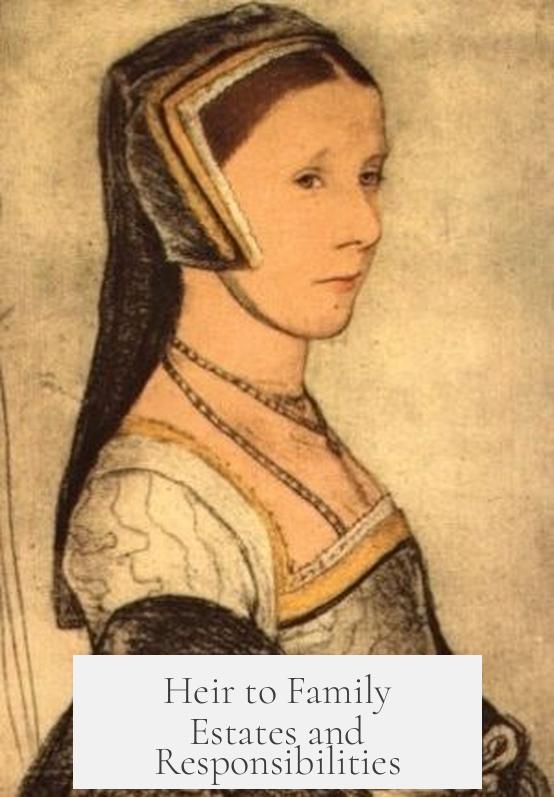
By 1606, after his father’s death, Cresacre inherited both Yorkshire and Hertfordshire lands. Most of his surviving older brothers had also entered religious life, becoming priests or monks, disqualifying them from taking up the family mantle. So, despite being the youngest, Cresacre became the family’s linchpin on the secular front.
Managing these estates was no simple matter. Ownership wasn’t just about wealth—it was about status, influence, and navigating the challenges of being a Catholic landowner in a Protestant-dominated England.
Life as a Catholic Landowner During Religious Persecution
Cresacre married and fathered three children: a son and two daughters. The son was groomed to inherit the land, while the daughters both became Benedictine nuns. This clearly shows the family’s deep Catholic roots, even when their faith was a liability.
The More family didn’t hide their faith; they paid fines for recusancy, a legal penalty imposed on Catholics who refused to attend Anglican services. Imagine paying a tax on your beliefs. Yet their commitment never wavered.
Where Did He Live? From Mimms to Hereford
Starting in 1617, Cresacre settled in Mimms, Hertfordshire. Today, Mimms is better known for a motorway service station off the M25, but in Cresacre’s day, it was a quiet estate.
Interestingly, Cresacre didn’t hold onto his Hertfordshire lands indefinitely. In 1629, he handed them over to his son. This forward planning might have helped shield the family from growing political unrest.
A Man of Letters: Biographer of a Saintly Ancestor
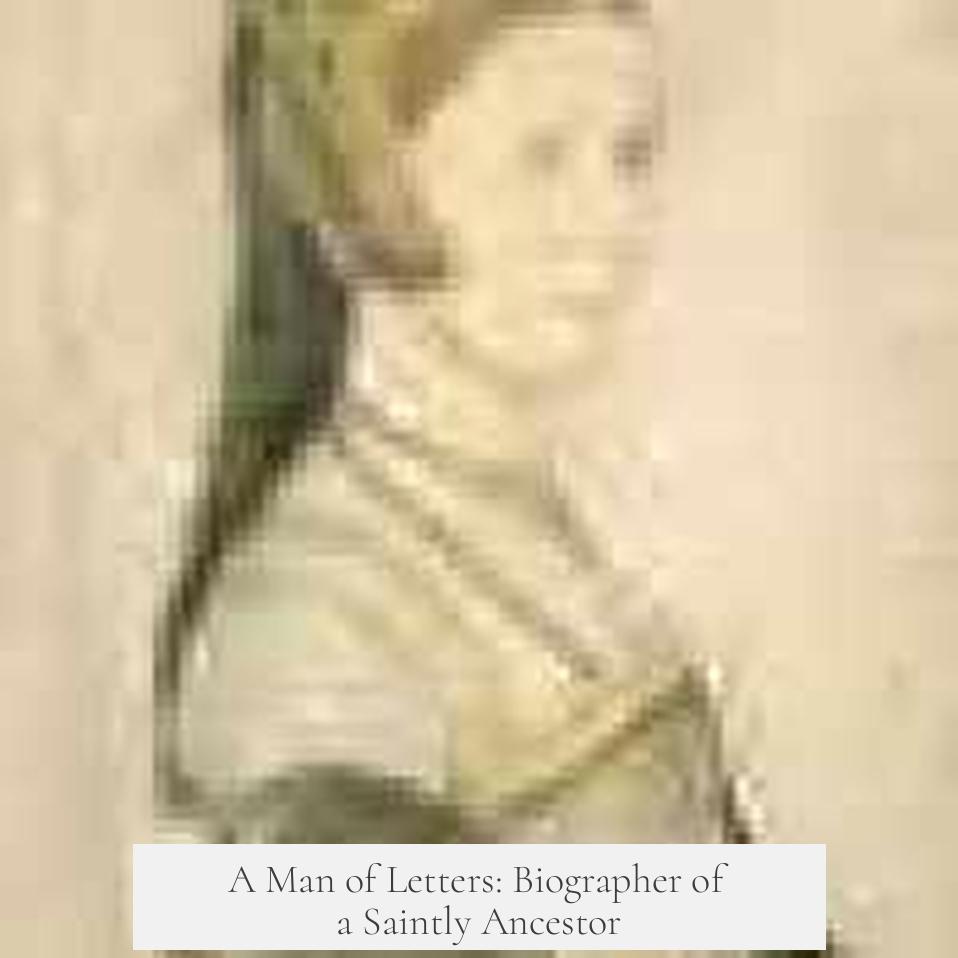
Between about 1616 and 1620, Cresacre embarked on writing a biography of his great-grandfather, Sir Thomas More, who famously died for his Catholic faith during Henry VIII’s reign. The biography wasn’t published until after 1626 in Douai, within the Spanish Netherlands, then a Catholic stronghold.
The book’s authorship is a bit tangled. While the dedication page credited Cresacre’s older brother Thomas, a secular priest, the preface hints the author was actually Cresacre—the youngest of 13—fitting his profile.Modern historians affirm Cresacre as the likely author, but back then, attribution was murky. Luckily, no one seemed to blame him for it, so no persecution followed.
Political Alignments: The English Civil War Factor
As the English Civil War (1642–1651) broke out, Cresacre found himself living in a complex political landscape. Hertfordshire and Essex, places where he had ties and property, leaned heavily toward Parliament. Cresacre’s move to a leasehold near Hereford, a royalist stronghold in the west country, is telling.
This move suggests he and his family supported the royalist side—the king’s cause—in the civil war. Loyal Catholics often aligned with royalists, hoping the monarchy would protect their embattled faith.
Final Years and Legacy
Cresacre More died in 1649, living modestly on his leasehold property near Hereford. From the youngest of thirteen children to a devout Catholic landowner, biographer, husband, father, and royalist sympathizer, his life journey was anything but ordinary.
Through it all, Cresacre maintained the More family’s Catholic identity and influence for more than a century after the martyrdom of his great-grandfather. His efforts as a landowner and author helped preserve this legacy amid England’s religious upheavals.
What Can We Learn from Cresacre More?
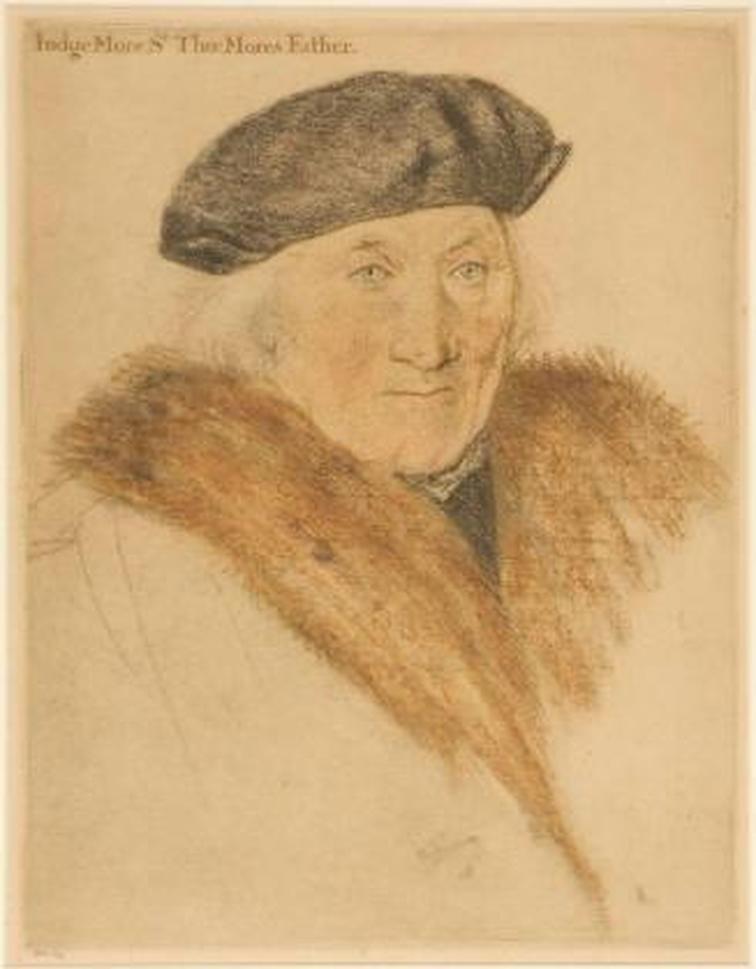
- Faith in Difficult Times: Cresacre shows how deeply rooted faith can persist despite legal and social penalties.
- Family as Duty: His shift from religious life to estate heir reveals family needs sometimes outweigh personal ambitions.
- Adaptability: Managing land, writing biography, relocating in wartime—he adapted to changing circumstances with resilience.
- Legacy Preservation: His biography of Sir Thomas More helped immortalize the family’s story, giving voice to history and faith.
A Final Thought
So, what happened to Cresacre More? The quiet nobleman who stepped up when others stepped away. The man who balanced faith, family, politics, and authorship in a turbulent era. He didn’t live under the spotlight, but his story enriches our understanding of the post-Reformation English Catholic experience.
Isn’t it remarkable how a man born into a large family navigating turbulent times still found ways to honor his ancestors and safeguard his descendants’ future? Cresacre More’s life reminds us that history often unfolds in quiet, unassuming ways—and those stories matter.
Sources and Further Reading
- Oxford Dictionary of National Biography: Judith H. Anderson’s comprehensive entry on Cresacre More (2004).
- Essex Recusant (1959–1964): Local history journal with detailed articles on the More family’s recusant activities.
What role did Cresacre More play in preserving the legacy of Sir Thomas More?
Cresacre More wrote a biography of his great-grandfather between 1616 and 1620. It was published in Douai after 1626. The book was attributed to him only in modern times.
How did Cresacre More manage his family estates?
He inherited family estates in Yorkshire and Hertfordshire after his father’s death in 1606. In 1629, he settled his Hertfordshire lands on his son.
Why did Cresacre More never fully become a monk despite his early religious training?
He entered Jesuit schooling at 12 and took minor orders in 1590. However, he was recalled to England after his eldest brother’s death and never took full orders.
Where did Cresacre More spend his final years, and why is this significant?
He lived near Hereford when he died in 1649. This area was a royalist stronghold during the civil war, suggesting his family likely supported the royalist cause.
Did Cresacre More remain faithful to Catholicism throughout his life?
Yes, Cresacre stayed Catholic and paid fines for recusancy. His daughters both became Benedictine nuns, showing the family’s continued Catholic commitment.
